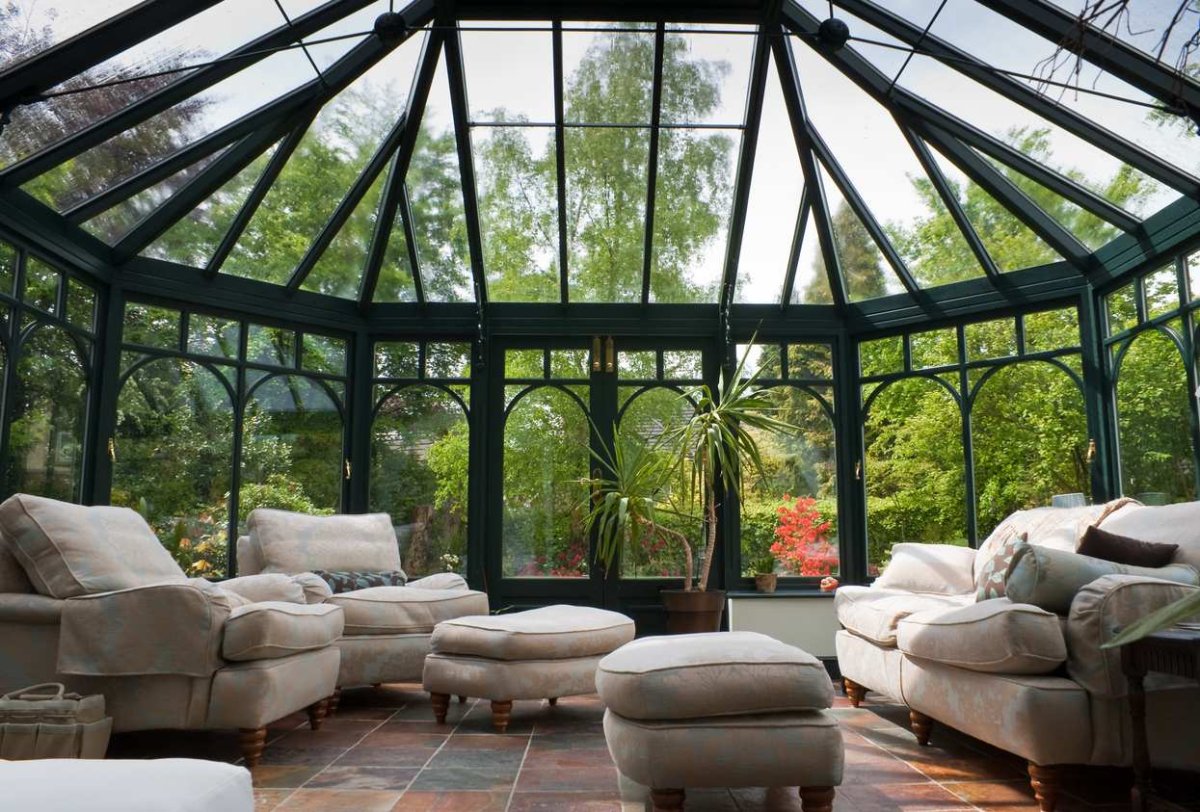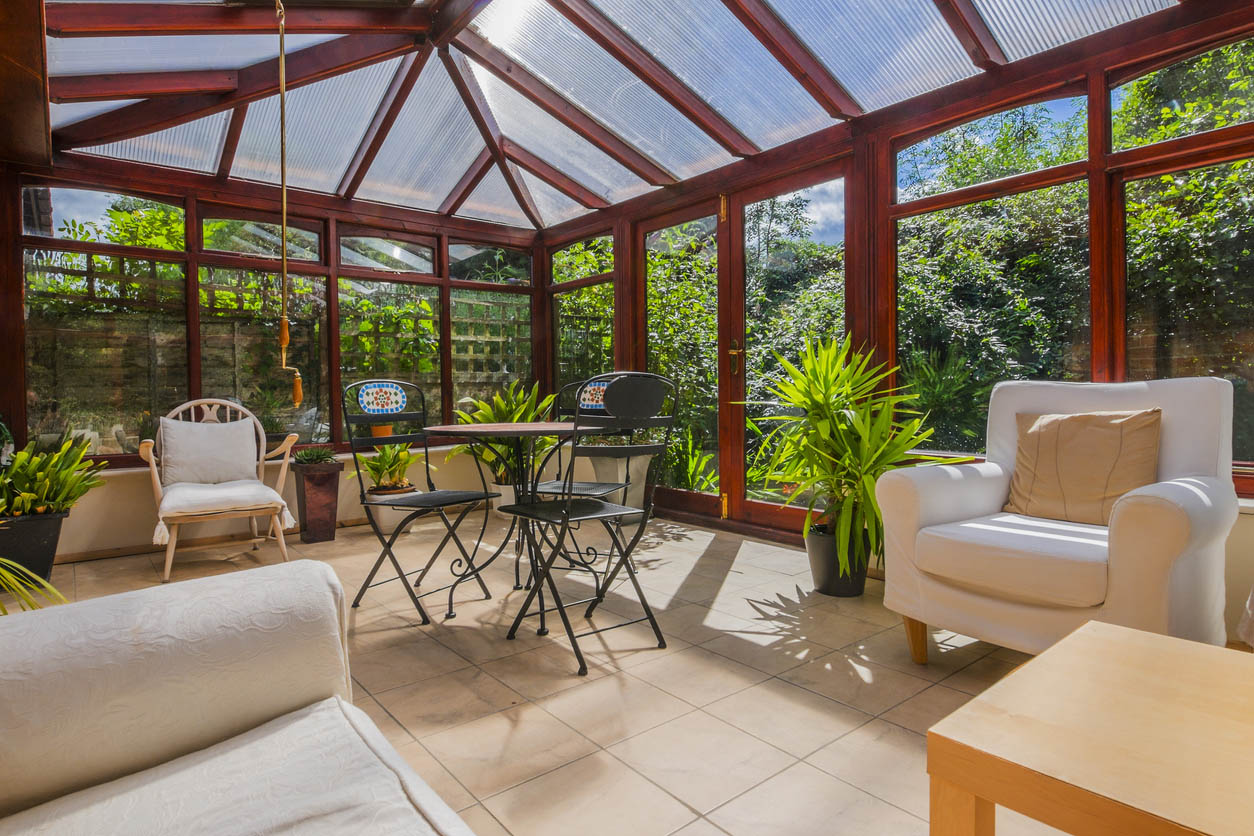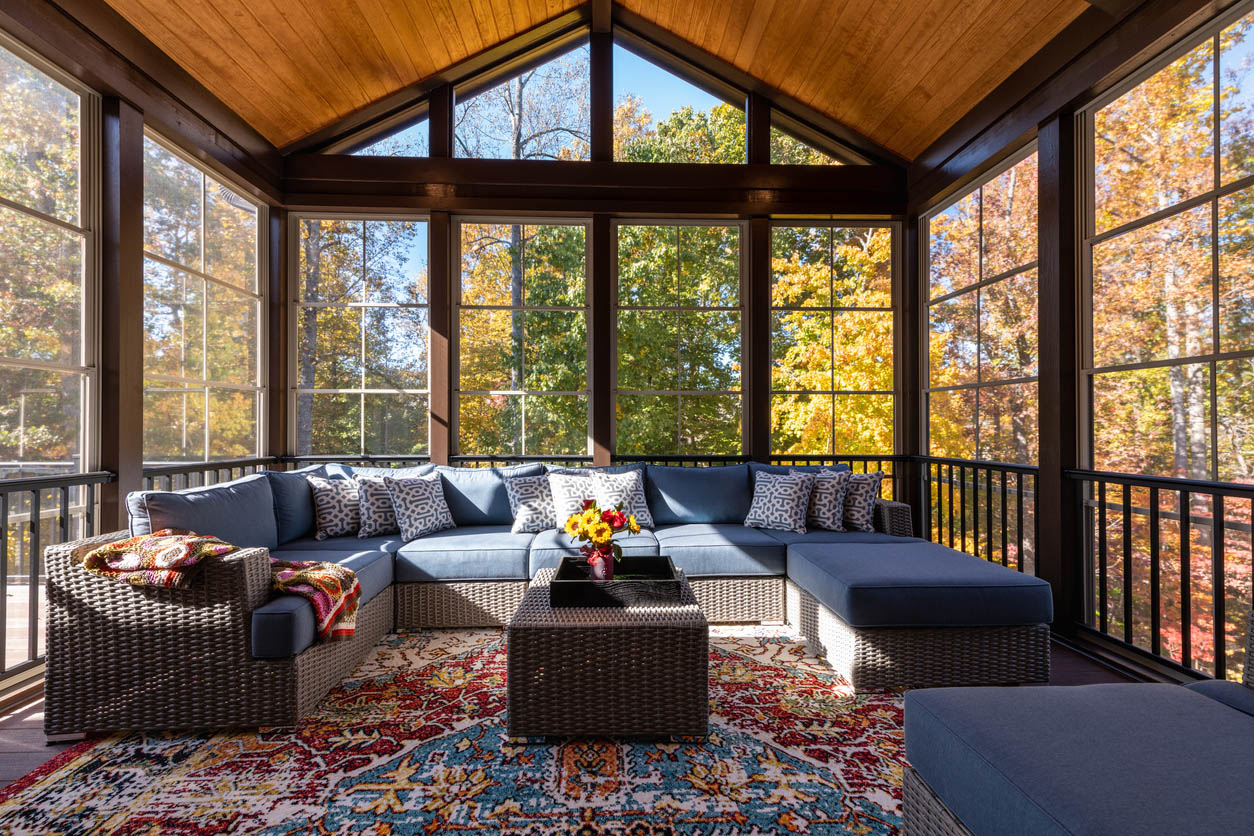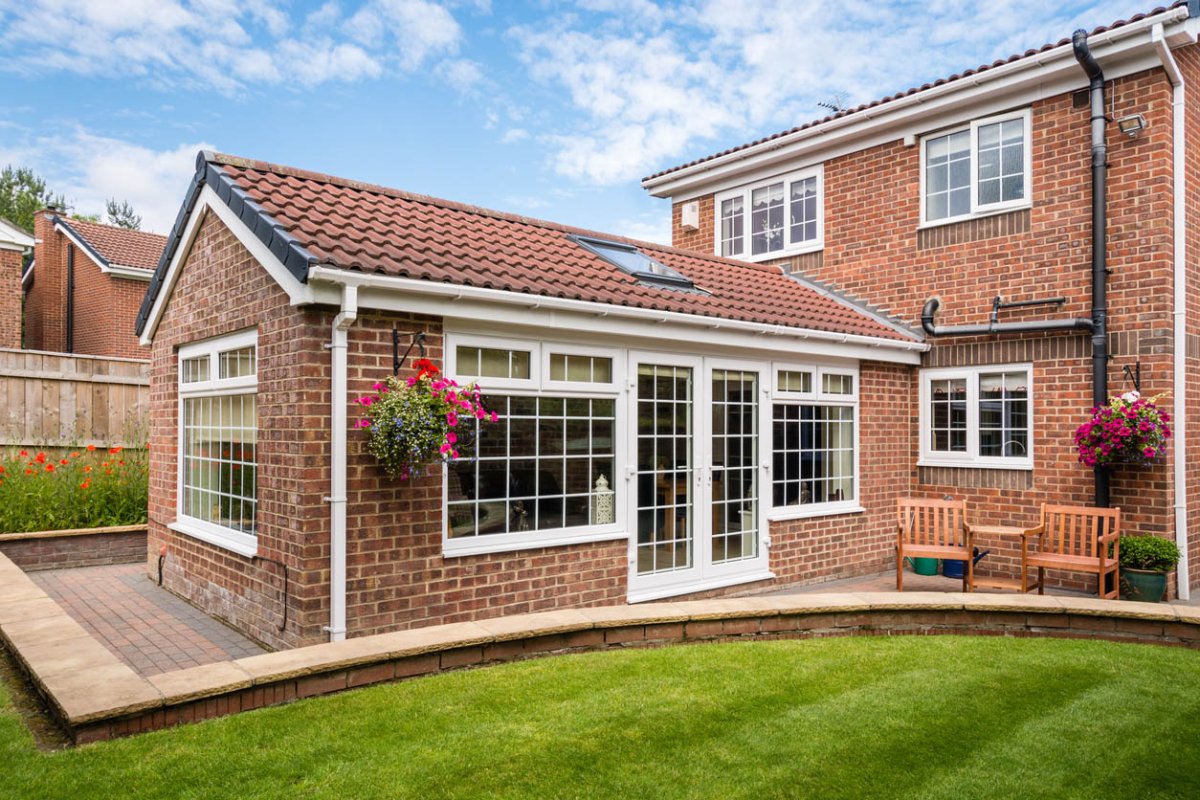We may earn revenue from the products available on this page and participate in affiliate programs. Learn More ›
Highlights
- The typical cost to build a sunroom ranges from $20,800 to $72,600, while the national average cost is $47,000.
- The main factors that affect the cost to build a sunroom include the type and size of the sunroom, the cost of labor and permits, and the cost of materials.
- Building a sunroom has numerous benefits, such as a high return on investment, a year-round space for gardening, and additional light and living space.
- Sunroom construction is a very labor-intensive project. Unless a homeowner has professional construction experience, this is a project best left to a professional.
In this era of bright LED lights, more and more people are craving natural light. Bigger windows or more windows—however homeowners can add more light, it’s being done. A popular way to enjoy more natural light in a special space is to add a sunroom to your house. It’s like a greenhouse for humans, which makes sense since humans also need sunlight as it’s the best source of natural vitamin D. The question remains: How much will a sunroom cost? On average, the addition of a sunroom ranges from $20,800 up to $72,600. Most homeowners pay around $47,000 for a sunroom, which includes labor.
Much of the cost depends on how large the sunroom is and the materials used. Since building a sunroom is much like other construction projects, you can expect similar considerations for labor, permits, and site preparation. You’ll also need to decide if you want it to be used for three seasons or insulated and climate-controlled for year-round use, as that will also affect the total price. Keep reading to discover everything you need to know about sunroom cost.

Key Cost Factors
The cost to build a sunroom can only be estimated after you’ve decided on what type of sunroom you prefer. A four-season sunroom cost is higher since it requires mechanical equipment to maintain a comfortable temperature. There are also prefab options to consider. Otherwise, most sunroom costs are driven by the size, type, labor, and materials.
Size and Type
There are a few types of rooms that are considered sunrooms:
- A four-season sunroom is climate controlled for year-round use and can cost between $25,000 and $80,000.
- A three-season sunroom stays warm enough for use from spring through fall and can run between $10,000 and $40,000.
- Conservatories are ideal for growing plants year-round in milder climates and cost between $5,000 and $80,000.
- Glass solariums utilize glass for the roof as well as the walls and can run $30,000 to $75,000.
- Atriums with roofs enclose a space with a glass roof and can cost $10,000 to $35,000.
- Prefab sunroom kits usually include installation of a specific style of sunroom. These will run between $5,000 and $30,000.
Naturally, the size of the sunroom will also affect the cost since a larger space takes more materials and labor to build. On average, expect to pay between $150 and $300 per square foot for sunroom costs. A small 8-foot by 10-foot sunroom costs around $4,000 to $6,000, but a 12-foot by 20-foot sunroom might average around $20,000. The final cost will also depend on the type of sunroom you choose since an insulated sunroom will cost more than a simple atrium.
Labor and Permits
Since a sunroom addition cost falls under the construction category, you can expect that labor makes up a significant portion. It’s labor-intensive to add windows and doors, especially if they’re made of glass. Not to mention there are a lot of specialty jobs included such as pouring concrete, electrical wiring, and possible HVAC installation. A four-season room cost for labor could run from $10,000 to $20,000, while a three-season sunroom might cost only $5,000 to $10,000 in labor.
Permits are a necessary cost since this is a home addition that will require some construction. Check with your local municipality to find out what permits you’ll need, or ask your sunroom contractor what’s required. Plan ahead since obtaining these permits can take several weeks, or even longer. You’ll likely pay on the lower end of the typical $400 to $1,800 cost for home addition permits. Don’t skip this—you’ll need the permit for any potential insurance claims down the road.
Materials
Materials make up the most of sunroom costs, so expect to pay at least half or more in the cost of materials. These costs include everything from wiring to framing to glass windows to the concrete pad. The materials for a four-season sunroom cost between $10,000 and $60,000, but a three-season sunroom might only cost $5,000 to $30,000.

Additional Costs and Considerations
Depending on the scope of your project, building a sunroom could become a serious venture that involves the help of an architect, expanding the foundation, and adding insulation, roofing, and doors. Even more complex is the addition of utilities and mechanical systems if you prefer a year-round sunroom. These costs may or may not apply to your final sunroom cost, but they’re helpful to know if needed.
Hiring an Architect
If your sunroom plans are extensive, it’s possible you’ll need an architect to review the integrity of your home and foundation to make sure the new sunroom has the right structural support to prevent damaging the home. The money you spend on an architect for this situation is well worth it to avoid costly problems down the road. It usually costs $2,020 to $4,800 for an architect to draft an updated set of plans.
Site Preparation
You might be planning to put a new sunroom where you have existing landscaping or even a deck. In this case, you’ll need to consider the cost to remove any existing structures or materials to make way for the new sunroom. This could also include any grading that might need to happen if your property has a slope near the house. Clearing a site for new construction could cost between $500 and $5,600, and you’ll pay around $700 for tree removal.
Foundation
A sunroom of any consequence will need a foundation to support the weight evenly. Assuming there is no existing foundation that can be used, you’ll need to have one built for an average cost of $1,000 to $6,000 depending on the size.
Insulation
You might have insulation installed during construction to make the sunroom more pleasant during the cooler months. Most insulation costs for a single room average $500 to $1,500, or you can calculate an average cost per square foot at $0.70 to $1.30.
Roofing
The cost of the roof is entirely dependent on the type of sunroom you’re planning to build. A glass roof for a solarium will cost much more than an asphalt shingle roof. For example, the average cost of a glass and steel roof is $8,500, but an asphalt shingle roof costs around $3,600.
Windows and Doors
Sunrooms are designed to let in far more light than the average room. Sometimes they’re built as an enclosed space with glass walls, and other times they have numerous windows and a door to exit to the yard. Windows and doors increase sunroom costs, so plan for $3,500 to $15,000 for windows and $1,000 to $8,000 for sliding or patio doors.
Electricity, HVAC, and Plumbing
It’s unusual to build a sunroom without electricity, so plan on this cost—even if it’s just to power your reading light. Electricians usually cost between $50 and $100 per hour. It will cost more to install electrical outlets ($130 to $270), overhead lighting ($150 to $800), and an automated home system ($400 to $1,800).
A four-season room cost is higher due to the addition of an HVAC system. You can opt for ductless mini-split systems ($2,000 to $14,500) or a traditional HVAC system add-on ($4,000 to $6,000).
Cleanup
Most contractors will include the cost of site cleanup in their bid, but it’s best to ask and make sure. You don’t want to be stuck having to dispose of construction debris. If you need to rent a dumpster yourself, expect to pay between $300 and $525. Cleaning up the site could cost $280 to $670.

Types of Sunrooms
It might surprise you to learn there are several kinds of sunrooms you can build. In fact, there are six different types you can choose from as you plan this project.
Prefab vs. Custom
Like many projects that improve the home or outdoor living space, there are prefab sunroom options. These provide a more affordable or quicker way to build a sunroom, but there are limitations in terms of design, material, and size. Prefab sunrooms can cost between $5,000 and $30,000, and they’re usually made of aluminum or vinyl. Some of the more popular brands include Champion, Patriot, California Sunrooms, and Sunspace. Sometimes the manufacturer includes installation in the costs, so it’s best to ask what’s included in the price.
Custom sunrooms are a popular option for homeowners looking to build an inviting space that suits their design preferences. There are more options in terms of materials and even size, not to mention it’s the better choice if you’re looking to have a climate-controlled environment. Custom sunrooms cost between $5,000 and $80,000, but they usually average $30,000.
Four-Season Room
A four-season room cost averages from $25,000 to $80,000. The cost is higher since this type of sunroom is built to withstand the extreme temperatures of any season in any climate. Adding a four-season sunroom is almost like adding an extension onto your house—with more glass than is typical.
Three-Season Room
Three-season rooms are a popular choice for homeowners since they’re usually a little cheaper while still extending the use of the outdoor space for more of the year. The best three-season rooms are almost like a cozy patio enclosure that keeps you warmer in the fall and spring than an open patio would. Depending on your region, you’ll need a way to cool it in the summer or heat it in the winter if you plan to use it often. On average, three-season sunrooms cost $10,000 to $40,000.
Glass Solarium
A glass solarium is the most eye-catching solution for adding a sunroom. This style includes a glass roof to allow in maximum sunlight. The structure is usually made of steel to help support the weight of the glass. Glass solariums are the most expensive kind of sunroom, coming in at $30,000 to $75,000.
Conservatory
For green-thumb enthusiasts, a conservatory might be the ideal solution. These are typically climate controlled and often have a glass roof as well, so expect a higher price point here: $50,000 to $150,000. The advantage is that you can grow plants and food year-round in a conservatory. However, if you’re looking for a simpler garden room that isn’t well insulated or built with an HVAC system, the starting price could be as low as $5,000.
Atrium
Atriums are a little different than a typical sunroom in that the interior walls usually exist and only a glass roof is needed. Sometimes this room is planned during the building of a new home, and other times it can be adjusted during a renovation. Adding a glass roof for an atrium can cost between $10,000 and $35,000.
Benefits of Building a Sunroom
Sunrooms are a great way to improve your home’s value, start your growing season earlier, and enjoy Mother Nature’s beautiful sunshine more often.
Return on Investment
Many homeowners ask whether the cost to add a sunroom is worth the investment. According to HomeAdvisor, there’s a 49 percent return on investment (ROI) when you add this extra space.
Gardening and Planting Benefits
Whether you’re an old pro with a garden trowel or a newbie just learning to keep a plant healthy, sunrooms offer an extra space to enjoy healthy plants. With a sunroom, seeds can sprout strong and healthy while the weather is still iffy outside before planting season. And for those who live in cooler climates, it’s the perfect place to grow indoor fruit trees that can’t handle winter weather.
Extra Light and Space
Enjoying more sunshine is a genuine mood lifter and may boost your immune system. Our bodies thrive on natural vitamin D, so having a space where you can sun yourself without a cold breeze is a smart idea. It’s the perfect way to enjoy a morning cup of coffee and your favorite book even when it’s too chilly to be outside. And the added space also lets you escape to a quieter area when the family room is full of kids and family.

DIY vs. Hiring a Professional
The DIY route is a tempting one to take when you’re considering adding a sunroom. After all, it’s not necessarily a livable space—just an enclosed space. But therein lies the pitfall. Even something as simple as a three-season sunroom must be structurally sound to ensure you and your family are safe. There are only two conditions where a DIY method can be safely considered: if you’re already a general contractor or skilled laborer, or if you purchase a simple prefab kit. Even with a prefab kit, there are risks to building the structure improperly, so beware of this route if you’re inexperienced at this type of building.
To ensure your investment lasts a long time and is safe to use even in windy conditions, opt to search for “best sunroom builders near me” and hire a pro who can get the job done without hesitation. Even if you choose a prefab sunroom, you may have the option to have a pro install it as well. Most importantly, you’ll have to hire a pro to install any HVAC or electrical systems you might need. A general contractor can usually recommend several companies to use, or they will simply subcontract the job. Best of all, using a pro means the job should get done faster (compared to you working on it in your spare time), and the pro should carry insurance in case something happens.
How to Save Money
As with any construction project, homeowners often look for ways to reduce costs. Consider these tips to save money on your upcoming sunroom project.
- Decide whether a three-season sunroom or just a garden room is sufficient for your needs.
- See if a prefab kit suits your space and design preference.
- DIY the interior finish work for a four-season sunroom. You might be able to do the painting and other simple tasks.
- Try to position the sunroom where you already have an existing door to save on that expense.
- Skip the HVAC system and use portable heaters or fans.
- Add a cheaper ductless mini-split system rather than extending your HVAC system.
- Avoid rushing the process and choosing a style or materials that don’t fit your budget or your needs.
- Fill the interior with thrifted or upcycled furniture rather than paying the cost of brand-new furniture.
- Reduce the number of outlets you install to only the side that touches the rest of the house. This requires less time and materials.
- Ask for multiple quotes with multiple options from more than one contractor.
- Sign up for emails from prefab sunroom companies to purchase a kit during a seasonal or holiday sale.
Questions to Ask a Pro
Deciding to build a sunroom shouldn’t be a hasty decision. The same goes for choosing a sunroom contractor. Above all, make sure the company is licensed, bonded, and insured according to all local regulations. Then use the following questions to understand the process and clear up any misunderstandings as you decide who to hire.
- How long have you been in business and built sunrooms?
- Can I review a portfolio of your work?
- Do you require a deposit?
- Can I review a line-item invoice or contract first?
- Have you ever built a glass solarium before?
- Do you work with any prefab kits that you recommend?
- What kind of preparation will my site need?
- Will you obtain any necessary permits?
- How can I decide how big to build my sunroom?
- Where should I build my sunroom?
- Are most sunrooms in my area insulated or can I just use a space heater/fan?
- Will I need to hire an architect?
- What’s the cost difference if I choose to build this size of a three-season room versus a four-season room?
- What’s the cheapest kind of door I can install to get to the backyard?
- Are there common issues you’ve seen when homeowners install a sunroom, such as flooding, leaks, etc.?
- What’s the cheapest sunroom I can install?
- How long will the project take?
- Do you complete all the work, or will you need to subcontract anything?
- Will there be a supervisor on-site at all times?
- Will you need access to the interior of my house?
- How will you protect the rest of my house and property during construction?
- Will you clean up all the construction debris? If so, how much will that cost?
- What kind of warranties or guarantees are included?
FAQs
Sunroom costs are complex to calculate since there are several variables like size, type, and material choices. Using the average cost ranges can help you decide which style fits your budget. Still, you might have more questions about sunroom costs in general. Here are several helpful answers to commonly asked questions.
There are pros and cons to adding a sunroom to your home. They don’t have as high of an ROI as renovating a bathroom or kitchen, but they do still add value to your home. On the other hand, it’s costly to build an all-season sunroom, so it might not feel like a good investment. You’ll need to decide how much you’d like to have an extra space for entertaining guests, enjoying more sunshine, growing plants, or enjoying hobbies. The benefits are quite real and tangible if the budget allows.
Definitely. Many kinds of sunrooms are ideally suited for colder climates. You can choose to build a four-season sunroom that’s fully insulated and climate controlled. It basically becomes an addition to your home—with tons more sunlight. But if your budget doesn’t allow for a four-season room, you can ask a contractor about doing partial insulation or alternatives for adding heat during those chilly months.
Some sunrooms are like adding onto your house. In those cases, it can take up to 12 weeks to build a sunroom since the contractor will need to build a foundation and add mechanical systems. The size of the project will also influence how long it takes. Prefab kits generally take less time to build, but it’s still a job that can’t be done in just a day or two.
Assuming the sunroom wasn’t built with an HVAC or ductless system to help control the temperature, there are a few ways to help manage the temperature in your sunroom.
1. Install a fan in the ceiling and set it to push hot air down from the ceiling and recirculate it slowly back into the room.
2. Add a space heater that is safe to use in an enclosed area under supervision.
3. Install at least two windows to create a breezy draft.
4. Add insulated drapes to the windows. Keep them open during the day to allow in the warm sunlight, then close them when the sun goes down to trap the warmth inside.
5. Add tinting to the windows to prevent the radiant heat from going back out the window.
6. Make sure windows and doors are sealed and have weatherstripping.
Ideally, a sunroom should be built facing south where the sun can shine on it continuously throughout the day. If that’s not an option, then choose an east-facing sunroom to enjoy the sunrise or a west-facing sunroom for evening sunsets. If you’re planning to use it as a dining area, try to plan it as close to the kitchen as possible. Finally, you might need to reconsider the location of existing trees if there will be too much shade where you want to build the sunroom.
Angi, HomeAdvisor, Homeserve, Thumbtack

